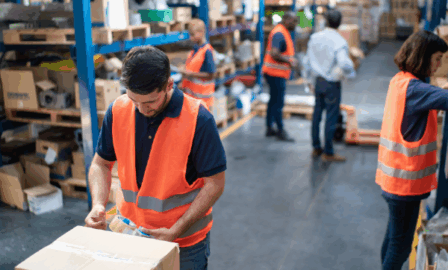The Business of a Circular Economy
As supply chain woes continue to plague businesses across industries, many organizations are realizing the benefit a circular economy can have to their business beyond sustainability. The sustainability impacts of a circular economy remain significant – offering the potential to reduce global carbon dioxide equivalent (CO2e) emissions by 40% by 2050. By nature, a circular economy helps to improve the security of the supply of raw materials, making it a viable strategy for alleviating the supply chain pressures that so many have felt over the course of the COVID pandemic. Furthermore, the transition to a circular economy has well-documented benefits to innovation capabilities and opportunities. As reported by the World Resources Institute, the transition to a circular economy has the potential to bring about trillions of dollars in market value and encourages innovation in long-held business practices.
Rather than a linear economy, which values the take, make, and dispose model, the goal of a circular economy is to design products in a more sustainable way by eliminating waste and using resources in a more circular way. This often means that companies come up with unique ways to reuse or recycle materials for different products. This results in a more fluid and cyclical supply chain with more ambiguous endpoints, as wastes are repurposed into raw materials or power sources for use in manufacturing another product.
Circular economies have come to life in a variety of ways. In 2018, AB-InBev launched a protein drink made from spent grains that were left over from the brewing process. Rent the Runway reached unicorn status last year based off a circular model of rented closets. And, Timberland partnered with tire manufacturer Omni United to recycle passenger vehicle tires into Timberland shoes.
The most important concept of the circular model is the idea that products should be manufactured in a way that best enables durability or flexibility for future reuse. Firms that transition to a circular manufacturing model can expect reduced costs, more stable supply chains, and increased operational coherence. However, beginning this transition can be difficult for some firms.
Circular Economy Implementation Challenges
To effectively change from a linear model to a circular one, companies must look closely at their supply chain. Additionally, investment and production costs can be a major hurdle for manufacturers. However, standardizing systems and information sharing can assist with these cost challenges. It is also important for an organization’s top leadership to structure a circular model and actively demonstrate buy-in to the process.
Food and beverage companies in particular have not been able to transition to a circular model easily due to a lack of standard and clear metrics used to determine the outcome of their efforts. Other outside factors impacting a company’s transition to a circular model include consumer awareness of the purpose and utilization of a circular economy and level of government support through tax and regulation policy. For example, industrial-scale composting is widely unachievable in the U.S. because too few facilities exist for this process, which would require government support to solve. This means that companies must actively educate the public about the benefits of a circular economy, and advocate for government involvement in assisting circular processes.
Getting Started
Using material flow analysis, companies can trace the efficiency and sourcing of materials within their local economy. In this sense, ASICS conducts Life Cycle Assessments to analyze impact and accordingly adjust design and production of their consumer goods to minimize negative environmental consequences. Two other major practices can be implemented internally to begin to switch to the circular economy. First, placing emphasis on zero waste manufacturing can provide major cost savings. Unilever used landfill diversion, smart sourcing, and production waste reuse to save $226 million, demonstrating the fiscal benefits of zero waste sustainability efforts. Second, circular packaging can also create positive results. Coca-Cola has implemented this practice in a variety of ways, such as reusing glass bottles, developing plant-based plastic technology, and utilizing partnerships to create upscale products made from bottle and can waste.
Taking advantage of new circular opportunities discovered through a material flow analysis can give businesses a competitive advantage, help a firm explore new revenue sources, and contribute to long-term environmental and social sustainability efforts, which will be positively viewed by consumers. Because of the emphasis on customer satisfaction from corporate social responsibility, qualitative key performance indicators can be beneficial for firms to conduct analysis on the consumer response to new circular practices.
Though some challenges in switching to the circular model exist, with a potential global market size of $4.5 trillion, the circular economy offers strategic benefits and future profits for companies that act on this trend. Though current capabilities for implementing a circular model exist, in the future, acquiring improved sustainable manufacturing technology or gaining a better understanding of recently developed technologies can assist a company with maximizing the success of a circular economy initiative.
Subscribe to Clarkston's Insights
Contributions by Courtney Loughran.



